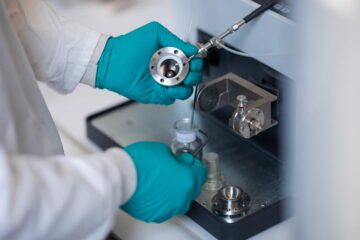Cobblestones fool innate immunity

“Activation of the body’s innate immune system is one of the most common reasons for an implant being rejected,” explains Professor Hans Elwing from the University of Gothenburg’s Department of Cell and Molecular Biology. “We can now show why the body more easily integrates implants with a nanostructured surface than a smooth one.”
The researchers used a unique method to produce nanostructures on gold surfaces, creating gold particles just 10-18 nm in diameter and binding them to a completely smooth gold surface at carefully regulated distances. The result is something akin to a cobbled street in miniature.
Nanosized irregularities mimic body’s natural structures
Giving implants this cobbled surface reduces the activation of important parts of the innate immune system. This is because several of the proteins involved are of a similar size to these nanosized cobbles, and so do not change in appearance when they land on the surface. This gives the body a greater ability to integrate foreign objects such as implants, pacemakers and drug capsules into its own tissues, as well as reducing the risk of local inflammation.
“It may be that the innate immune system is designed to react to smooth surfaces, because these are not found naturally in the body,” says Elwing. “Some bacteria, on the other hand, do have a completely smooth surface.”
Modern nanotechnology makes it easy and cheap to surface-treat implants and drug capsules, but it will probably be several years before this becomes a reality in human medicine. The focus now is on customising titanium implants of various kinds.
Surface can be graded
“We’ve developed a graded surface with different cobbelstone package that we think can be used for bone implants,” says Elwing. “Bone is very hard on the outside but then gets softer, so it would be good to have hard integration on the surface and softer integration underneath. We reckon we can make titanium screws that are denser at the head of the screw so that they fuse best at the top. This kind of customisation is the future.”
Research into the body’s innate immune system was rewarded this year with the Nobel Prize in Physiology or Medicine.
The laboratory work was carried out at the University of Gothenburg, and the project is a collaboration between the BIOMATCELL centre of excellence in Gothenburg, SP Technical Research Institute of Sweden in Borås and Bactiguard AB in Stockholm.
The article “Immune complement activation is attenuated by surface nanotopography” by Mats Hulander, Anders Lundgren, Mattias Berglin, Mattias Ohrlander, Jukka Lausmaa and dx.doi.org/10.2147/IJN.S24578Hans Elwing was published in the International Journal of Nanomedicine:
Contact:
Hans-Björne Elwing, Department of Cell and Molecular Biology
Tel: +46 (0)31 786 2562
Mobile: +46 (0)733 604 607
hans.elwing@cmb.gu.se
Media Contact
More Information:
http://www.gu.seAll latest news from the category: Health and Medicine
This subject area encompasses research and studies in the field of human medicine.
Among the wide-ranging list of topics covered here are anesthesiology, anatomy, surgery, human genetics, hygiene and environmental medicine, internal medicine, neurology, pharmacology, physiology, urology and dental medicine.
Newest articles

Security vulnerability in browser interface
… allows computer access via graphics card. Researchers at Graz University of Technology were successful with three different side-channel attacks on graphics cards via the WebGPU browser interface. The attacks…

A closer look at mechanochemistry
Ferdi Schüth and his team at the Max Planck Institut für Kohlenforschung in Mülheim/Germany have been studying the phenomena of mechanochemistry for several years. But what actually happens at the…

Severe Vulnerabilities Discovered in Software to Protect Internet Routing
A research team from the National Research Center for Applied Cybersecurity ATHENE led by Prof. Dr. Haya Schulmann has uncovered 18 vulnerabilities in crucial software components of Resource Public Key…





















